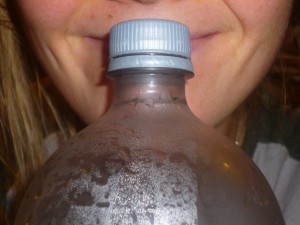Bloomberg’s Pull on New Yorkers’ Waistlines
by aintveld | October 3, 2012 5:30 pm
Mayor Bloomberg’s Ban on large sodas has some realizing the sour side to sweet treats.
By ASHLEY INTVELD
Controversy over New York City Mayor Michael Bloomberg’s large soda ban has stretched farther than America’s waistband; the measure has cast a spotlight on an America’s obesity epidemic.
New York’s Board of Health, on September 6, approved the ban which restricts soda and other sugary beverages to be sold at a 16 ounce maximum[1]. With one in three United States adults being obese[2], Bloomberg’s reason for pitching the ban was to curb the obesity epidemic that has plagued America in recent years.
 [3]
[3]“I can see Bloomberg’s point in cracking down on the sugar consumption,” Ramapo student Rich Sorce said. “Having an abundant amount of sugar is terrible for the body. I think this ban will obviously control how much people have, but it will also get them to research why sugary drinks are so bad for you,” he added.
 [4]
[4]Health studies have shown that sugar and high fructose corn syrup limit the brain’s ability to sense leptin, the hormone that signals the brain that the body has consumed enough food. Because the brain is unable to read this signal, hunger persists and overeating occurs. With high fructose corn syrup listed as an ingredient in 80 percent of food items[5] in America, it is plain to see Bloomberg’s incentive to reduce the risk of the population’s compromised health. Soft drinks, like Coca-Cola[6], lists high-fructose corn syrup as their second ingredient in the beverage.
Supporters of the sugar band feel as though this may be a transition toward the greater good, but others feel as though sugar is just the tip of the iceberg for foods that are detrimental to our health.
“I think it’s a very small step in a good direction, but you if you can still buy as many cigarettes and Big Macs as you want, the impact will hardly be noticed,” Sorce said.
Although some see the sugar ban as a protective measure against health ailments, others see it as an intrusion on our freedom as consumers. Eliot Hoff, spokesperson from New Yorkers for Beverage Choices[7], says, “We believe that we can choose what we drink and how much we drink.”
Fairlawn resident John Salinas said, “If someone is going to give me dietary restrictions, I’d prefer it to be my doctor and not a person of political stature. To deny people the things they wish to consume is more of a parental role than it is a political role anyway.”
From 1920 to 1933, America experienced the Prohibition which forbid the sale of alcohol in America. The result was the development of organized crime, the black market, and racketeering. In essence, the forbiddance of alcohol made the product more desirable, and so the market flourished illegally. Salinas said, “The Prohibition is an extreme example to compare this to, but it’s the same idea. If you tell someone ‘no,’ they’re going to push just a little bit harder to do it.”
Restricting the buyer’s ability to consume has been considered a limitation of consumer’s rights, but some see this as an ideal business opportunity. East Rutherford resident Katelyn Naranjo said, “I think the ban has the potential to be a decent sales market for soda companies and the companies that sell the soda. If people want their soda fix, they won’t stop at buying one sixteen-ounce cup. They’ll buy two or three sixteen-ounce cups to get their fill.” According to a poll published in The New York Times[8], 60 percent of New Yorkers are opposed to the soda ban, which influenced soft-drink companies to protest the movement which is due to begin on March 12, 2013.
Sorce said, “I think it’s important that people understand why Bloomberg put this into action more than just seeing it as a restriction. He’s taking away the rights for people to say, ‘yes, I want to be unhealthy,’ and really, is that so bad?”
- 16 ounce maximum: http://www.sugarstacks.com/beverages.htm
- obese: http://www.cdc.gov/obesity/data/index.html
- [Image]: http://class1.ramaporecord.org/2012/10/03/bloombergs-pull-on-new-yorkers-waistlines/photo8/
- [Image]: http://class1.ramaporecord.org/2012/10/03/bloombergs-pull-on-new-yorkers-waistlines/p1040428/
- 80 percent of food items: http://www.youtube.com/watch?v=Yda8RtOcVFU&feature=plcp
- Coca-Cola: http://productnutrition.thecoca-colacompany.com/products/coca-cola#ingredients
- New Yorkers for Beverage Choices: http://nycbeveragechoices.com/
- The New York Times: http://www.nytimes.com/2012/09/14/nyregion/health-board-approves-bloombergs-soda-ban.html
Source URL: https://class1.ramaporecord.org/?p=8427